Rice Husk with PLA: 3D Filament Making and Additive Manufacturing of Samples for Potential Structural Applications
Abstract
:1. Introduction
2. Materials and Experimental Methods
3. Results and Discussion
4. Discussion
5. Conclusions
Author Contributions
Funding
Data Availability Statement
Acknowledgments
Conflicts of Interest
References
- Yang, L.; Hsu, K.; Baughman, B.; Godfrey, D.; Medina, F.; Menon, M.; Wiener, S. Additive Manufacturing of Metals: The Technology, Materials, Design and Production; Springer Publishing Company: Berlin/Heidelberg, Germany, 2017. [Google Scholar] [CrossRef]
- ASTM International ASTM F2792-12; Standard Terminology for Additive Manufacturing Technologies. ASTM International: West Conshohocken, PA, USA, 2015.
- Pereira, T.; Kennedy, J.V.; Potgieter, J. A Comparison of Traditional Manufacturing vs. Additive Manufacturing, the Best Method for the Job. Procedia Manuf. 2019, 30, 11–18. [Google Scholar] [CrossRef]
- Mohanavel, V.; Ashraff Ali, K.S.; Ranganathan, K.; Allen Jeffrey, J.; Ravikumar, M.M.; Rajkumar, S. The Roles and Applications of Additive Manufacturing in the Aerospace and Automobile Sector. Mater. Today Proc. 2021, 47, 405–409. [Google Scholar] [CrossRef]
- Singh, S.; Ramakrishna, S. Biomedical Applications of Additive Manufacturing: Present and Future. Curr. Opin. Biomed. Eng. 2017, 2, 105–115. [Google Scholar] [CrossRef]
- Froes, F.; Boyer, R. Additive Manufacturing for the Aerospace Industry; Elsevier: Amsterdam, The Netherlands, 2019; ISBN 978-0-12-814062-8. [Google Scholar]
- Vergara, L.A.; Colorado, H.A. Additive Manufacturing of Portland Cement Pastes with Additions of Kaolin, Superplastificant and Calcium Carbonate. Constr. Build. Mater. 2020, 248, 118669. [Google Scholar] [CrossRef]
- Colorado, H.A.; Mendoza, D.E.; Valencia, F.L. A Combined Strategy of Additive Manufacturing to Support Multidisciplinary Education in Arts, Biology, and Engineering. J. Sci. Educ. Technol. 2021, 30, 58–73. [Google Scholar] [CrossRef] [PubMed]
- Colorado, H.A.; Cardenas, C.A.; Gutierrez-Velazquez, E.I.; Escobedo, J.P.; Neves Monteiro, S. Additive Manufacturing in Armor and Military Applications: Research, Materials, Processing Technologies, Perspectives, and Challenges. J. Mater. Res. Technol. 2023, 27, 3900–3913. [Google Scholar] [CrossRef]
- Divakaran, N.; Das, J.P.; Ajay Kumar, P.V.; Mohanty, S.; Ramadoss, A.; Nayak, S.K. Comprehensive Review on Various Additive Manufacturing Techniques and Its Implementation in Electronic Devices. J. Manuf. Syst. 2022, 62, 477–502. [Google Scholar] [CrossRef]
- Bae, E.J.; Do Jeong, I.; Kim, W.C.; Kim, J.H. A Comparative Study of Additive and Subtractive Manufacturing for Dental Restorations. J. Prosthet. Dent. 2017, 118, 187–193. [Google Scholar] [CrossRef]
- Colorado, H.A.; Mendoza, D.E.; Lin, H.T.; Gutierrez-Velasquez, E. Additive Manufacturing against the COVID-19 Pandemic: A Technological Model for the Adaptability and Networking. J. Mater. Res. Technol. 2021, 16, 1150–1164. [Google Scholar] [CrossRef]
- Siemiński, P. Introduction to Fused Deposition Modeling. In Additive Manufacturing; Elsevier: Amsterdam, The Netherlands, 2021; pp. 217–275. [Google Scholar] [CrossRef]
- Daminabo, S.C.; Goel, S.; Grammatikos, S.A.; Nezhad, H.Y.; Thakur, V.K. Fused Deposition Modeling-Based Additive Manufacturing (3D Printing): Techniques for Polymer Material Systems. Mater. Today Chem. 2020, 16, 100248. [Google Scholar] [CrossRef]
- Zhong, W.; Li, F.; Zhang, Z.; Song, L.; Li, Z. Short Fiber Reinforced Composites for Fused Deposition Modeling. Mater. Sci. Eng. A 2001, 301, 125–130. [Google Scholar] [CrossRef]
- Abeykoon, C.; Sri-Amphorn, P.; Fernando, A. Optimization of Fused Deposition Modeling Parameters for Improved PLA and ABS 3D Printed Structures. Int. J. Lightweight Mater. Manuf. 2020, 3, 284–297. [Google Scholar] [CrossRef]
- Pakkanen, J.; Manfredi, D.; Minetola, P.; Iuliano, L. About the Use of Recycled or Biodegradable Filaments for Sustainability of 3D Printing: State of the Art and Research Opportunities. Smart Innov. Syst. Technol. 2017, 68, 776–785. [Google Scholar] [CrossRef]
- Trivedi, A.K.; Gupta, M.K.; Singh, H. PLA Based Biocomposites for Sustainable Products: A Review. Adv. Ind. Eng. Polym. Res. 2023, 6, 382–395. [Google Scholar] [CrossRef]
- Hamad, K.; Kaseem, M.; Ayyoob, M.; Joo, J.; Deri, F. Polylactic Acid Blends: The Future of Green, Light and Tough. Prog. Polym. Sci. 2018, 85, 83–127. [Google Scholar] [CrossRef]
- Durpekova, S.; Bergerova, E.D.; Hanusova, D.; Dusankova, M.; Sedlarik, V. Eco-Friendly Whey/Polysaccharide-Based Hydrogel with Poly(Lactic Acid) for Improvement of Agricultural Soil Quality and Plant Growth. Int. J. Biol. Macromol. 2022, 212, 85–96. [Google Scholar] [CrossRef]
- Moustafa, H.; Youssef, A.M.; Darwish, N.A.; Abou-Kandil, A.I. Eco-Friendly Polymer Composites for Green Packaging: Future Vision and Challenges. Compos. B Eng. 2019, 172, 16–25. [Google Scholar] [CrossRef]
- Zhan, Y.; Wu, X.; Wang, S.; Yuan, B.; Fang, Q.; Shang, S.; Cao, C.; Chen, G. Synthesis of a Bio-Based Flame Retardant via a Facile Strategy and Its Synergistic Effect with Ammonium Polyphosphate on the Flame Retardancy of Polylactic Acid. Polym. Degrad. Stab. 2021, 191, 109684. [Google Scholar] [CrossRef]
- Bhagia, S.; Bornani, K.; Agarwal, R.; Satlewal, A.; Ďurkovič, J.; Lagaňa, R.; Bhagia, M.; Yoo, C.G.; Zhao, X.; Kunc, V.; et al. Critical Review of FDM 3D Printing of PLA Biocomposites Filled with Biomass Resources, Characterization, Biodegradability, Upcycling and Opportunities for Biorefineries. Appl. Mater. Today 2021, 24, 101078. [Google Scholar] [CrossRef]
- Rua, J.; Buchely, M.F.; Monteiro, S.N.; Echeverri, G.I.; Colorado, H.A. Impact Behavior of Laminated Composites Built with Fique Fibers and Epoxy Resin: A Mechanical Analysis Using Impact and Flexural Behavior. J. Mater. Res. Technol. 2021, 14, 428–438. [Google Scholar] [CrossRef]
- Rua, J.; Colorado, H.A.; Monteiro, S.N. Sandwich Composites from Recycled Plastic Bottles Combined with Epoxy Matrix and Fique Fabric. J. Nat. Fibers 2022, 19, 15422–15431. [Google Scholar] [CrossRef]
- Paternina Reyes, M.J.; Unfried Silgado, J.; Santa Marín, J.F.; Colorado Lopera, H.A.; Espitia Sanjuán, L.A. Cashew Nutshells: A Promising Filler for 3D Printing Filaments. Polymers 2023, 15, 4347. [Google Scholar] [CrossRef] [PubMed]
- Singh, A.K.; Bedi, R.; Kaith, B.S. Mechanical Properties of Composite Materials Based on Waste Plastic—A Review. Mater. Today Proc. 2020, 26, 1293–1301. [Google Scholar] [CrossRef]
- Barritt, J. An Overview on Recycling and Waste in Construction. Constr. Mater. 2016, 169, 49–53. [Google Scholar] [CrossRef]
- Plessis, C.D. A Strategic Framework for Sustainable Construction in Developing Countries. Constr. Manag. Econ. 2007, 25, 67–76. [Google Scholar] [CrossRef]
- Vergara, L.A.; Perez, J.F.; Colorado, H.A. 3D Printing of Ordinary Portland Cement with Waste Wood Derived Biochar Obtained from Gasification. Case Stud. Constr. Mater. 2023, 18, e02117. [Google Scholar] [CrossRef]
- Ordoñez, E.; Neves Monteiro, S.; Colorado, H.A. Valorization of a Hazardous Waste with 3D-Printing: Combination of Kaolin Clay and Electric Arc Furnace Dust from the Steel Making Industry. Mater. Des. 2022, 217, 110617. [Google Scholar] [CrossRef]
- Narlıoğlu, N.; Salan, T.; Alma, M.H. Properties of 3D-Printed Wood Sawdust-Reinforced PLA Composites. Bioresources 2021, 16, 5467–5480. [Google Scholar] [CrossRef]
- Zhang, W.; Cotton, C.; Sun, J.; Heider, D.; Gu, B.; Sun, B.; Chou, T.W. Interfacial Bonding Strength of Short Carbon Fiber/Acrylonitrile-Butadiene-Styrene Composites Fabricated by Fused Deposition Modeling. Compos. B Eng. 2018, 137, 51–59. [Google Scholar] [CrossRef]
- Ning, F.; Cong, W.; Hu, Y.; Wang, H. Additive Manufacturing of Carbon Fiber-Reinforced Plastic Composites Using Fused Deposition Modeling: Effects of Process Parameters on Tensile Properties. J. Compos. Mater. 2016, 51, 451–462. [Google Scholar] [CrossRef]
- Moreno-Sanchez, D.; Sanz de León, A.; Moreno Nieto, D.; Delgado, F.J.; Molina, S.I. Basalt Fiber Composites with Reduced Thermal Expansion for Additive Manufacturing. Polymers 2022, 14, 3216. [Google Scholar] [CrossRef]
- Kordi, M.; Farrokhi, N.; Pech-Canul, M.I.; Ahmadikhah, A. Rice Husk at a Glance: From Agro-Industrial to Modern Applications. Rice Sci. 2023; in press. [Google Scholar] [CrossRef]
- Bisht, N.; Gope, P.C.; Rani, N. Rice Husk as a Fibre in Composites: A Review. J. Mech. Behav. Mater. 2020, 29, 147–162. [Google Scholar] [CrossRef]
- Basri, M.S.M.; Mustapha, F.; Mazlan, N.; Ishak, M.R. Optimization of Rice Husk Ash-Based Geopolymers Coating Composite for Enhancement in Flexural Properties and Microstructure Using Response Surface Methodology. Coatings 2020, 10, 165. [Google Scholar] [CrossRef]
- Singh, S.; Kumar, V.; Kumar Parashar, A. A Study on the Substitution of Rice Husk Ash with Natural Sand of Cement Concrete. Mater. Today Proc. 2023; in press. [Google Scholar] [CrossRef]
- Shirgire, A.; Thenmozhi, S.; Praveen Jesuraj, V.; Shelar, A.; Chavhan, V.S.; Javanjal, V. Experimental Study on High Performance Concrete Using Rice Husk Ash. Mater. Today Proc. 2023; in press. [Google Scholar] [CrossRef]
- Mohamed, S.A.N.; Zainudin, E.S.; Sapuan, S.M.; Azaman, M.D.; Arifin, A.M.T. Energy Behavior Assessment of Rice Husk Fibres Reinforced Polymer Composite. J. Mater. Res. Technol. 2020, 9, 383–393. [Google Scholar] [CrossRef]
- ASTM International ASTM D638-14; Standard Test Method for Tensile Properties of Plastics. ASTM International: West Conshohocken, PA, USA, 2014.
- ASTM International D256; Standard Test Methods for Determining the Izod Pendulum Impact Resistance of Plastics. ASTM International: West Conshohocken, PA, USA, 2018.
- Muthadhi, A.; Anitha, R.; Kothandaraman, S. Rice Husk Ash—Properties and Its Uses: A Review. J. Inst. Eng. India Civ. Eng. Div. 2007, 88, 50–56. [Google Scholar]
- Ding, H.; Zhang, Y.; He, Z. Fracture Failure Mechanisms of Long Single PA6 Fibers. Polymers 2017, 9, 243. [Google Scholar] [CrossRef] [PubMed]
- Gao, H.; Qiang, T. Fracture Surface Morphology and Impact Strength of Cellulose/PLA Composites. Materials 2017, 10, 624. [Google Scholar] [CrossRef]
- Chacón, J.M.; Caminero, M.A.; García-Plaza, E.; Núñez, P.J. Additive Manufacturing of PLA Structures Using Fused Deposition Modelling: Effect of Process Parameters on Mechanical Properties and Their Optimal Selection. Mater. Des. 2017, 124, 143–157. [Google Scholar] [CrossRef]
- Tsou, C.H.; Yao, W.H.; Wu, C.S.; Tsou, C.Y.; Hung, W.S.; Chen, J.C.; Guo, J.; Yuan, S.; Wen, E.; Wang, R.Y.; et al. Preparation and Characterization of Renewable Composites from Polylactide and Rice Husk for 3D Printing Applications. J. Polym. Res. 2019, 26, 227. [Google Scholar] [CrossRef]
- Qin, S.; Chen, C.; Zhang, G.; Wang, W.; Wang, Z. The Effect of Particle Shape on Ductility of SiCp Reinforced 6061 Al Matrix Composites. Mater. Sci. Eng. A 1999, 272, 363–370. [Google Scholar] [CrossRef]
- Adeosun, S.O.; Aworinde, A.K.; Diwe, I.V.; Olaleye, S.A. Mechanical and Microstructural Characteristics of Rice Husk Reinforced Polylactide Nano Composite. West Indian J. Eng. 2016, 39, 63–71. [Google Scholar]
- Yiga, V.A.; Lubwama, M.; Pagel, S.; Olupot, P.W.; Benz, J.; Bonten, C. Optimization of Tensile Strength of PLA/Clay/Rice Husk Composites Using Box-Behnken Design. Biomass Convers. Biorefinery 2023, 13, 11727–11753. [Google Scholar] [CrossRef]
- Arjmandi, R.; Hassan, A.; Majeed, K.; Zakaria, Z. Rice Husk Filled Polymer Composites. Int. J. Polym. Sci. 2015, 2015, 501471. [Google Scholar] [CrossRef]
- Ebreo, A.; Hershey, J.; Vining, J. Reducing Solid Waste. Environ. Behav. 1999, 31, 107–135. [Google Scholar] [CrossRef]
- Heyer, K.U.; Stegmann, R. Landfill Systems, Sanitary Landfilling of Solid Wastes, and Long-Term Problems with Leachate. In Environmental Biotechnology: Concepts and Applications; Elsevier: Amsterdam, The Netherlands, 2005; pp. 375–394. [Google Scholar] [CrossRef]
- Makarichi, L.; Jutidamrongphan, W.; Techato, K.-A. The Evolution of Waste-to-Energy Incineration: A Review. Renew. Sustain. Energy Rev. 2018, 91, 812–821. [Google Scholar] [CrossRef]
- Tabasová, A.; Kropáč, J.; Kermes, V.; Nemet, A.; Stehlík, P. Waste-to-Energy Technologies: Impact on Environment. Energy 2012, 44, 146–155. [Google Scholar] [CrossRef]
- Goumans, J.J.J.M.; Senden, G.J.; van der Sloot, H.A. Waste Materials in Construction: Putting Theory into Practice. Stud. Environ. Sci. 1997, 71, 886. [Google Scholar]
- Javaid, M.; Haleem, A.; Singh, R.P.; Suman, R.; Rab, S. Role of Additive Manufacturing Applications towards Environmental Sustainability. Adv. Ind. Eng. Polym. Res. 2021, 4, 312–322. [Google Scholar] [CrossRef]
- Sauerwein, M.; Doubrovski, E.; Balkenende, R.; Bakker, C. Exploring the Potential of Additive Manufacturing for Product Design in a Circular Economy. J. Clean. Prod. 2019, 226, 1138–1149. [Google Scholar] [CrossRef]
- Lau, D.; Simons, R.; Srisuk, T.; Charoenlarp, K.; Kampeerapappun, P. Utilization of Waste Natural Fibers Mixed with Polylactic Acid (PLA) Bicomponent Fiber: Incorporating Kapok and Cattail Fibers for Nonwoven Medical Textile Applications. Polymers 2023, 16, 76. [Google Scholar] [CrossRef]
- Siakeng, R.; Jawaid, M.; Ariffin, H.; Sapuan, S.M.; Asim, M.; Saba, N. Natural Fiber Reinforced Polylactic Acid Composites: A Review. Polym. Compos. 2019, 40, 446–463. [Google Scholar] [CrossRef]
- Margallo, M.; Ziegler-Rodriguez, K.; Vázquez-Rowe, I.; Aldaco, R.; Irabien, Á.; Kahhat, R. Enhancing Waste Management Strategies in Latin America under a Holistic Environmental Assessment Perspective: A Review for Policy Support. Sci. Total Environ. 2019, 689, 1255–1275. [Google Scholar] [CrossRef] [PubMed]
- Khalid, M.Y.; Al Rashid, A.; Arif, Z.U.; Ahmed, W.; Arshad, H.; Zaidi, A.A. Natural Fiber Reinforced Composites: Sustainable Materials for Emerging Applications. Results Eng. 2021, 11, 100263. [Google Scholar] [CrossRef]
- Agudelo, G.; Cifuentes, S.; Colorado, H.A. Ground Tire Rubber and Bitumen with Wax and Its Application in a Real Highway. J. Clean. Prod. 2019, 228, 1048–1061. [Google Scholar] [CrossRef]
- Ezeah, C.; Fazakerley, J.A.; Roberts, C.L. Emerging Trends in Informal Sector Recycling in Developing and Transition Countries. Waste Manag. 2013, 33, 2509–2519. [Google Scholar] [CrossRef]



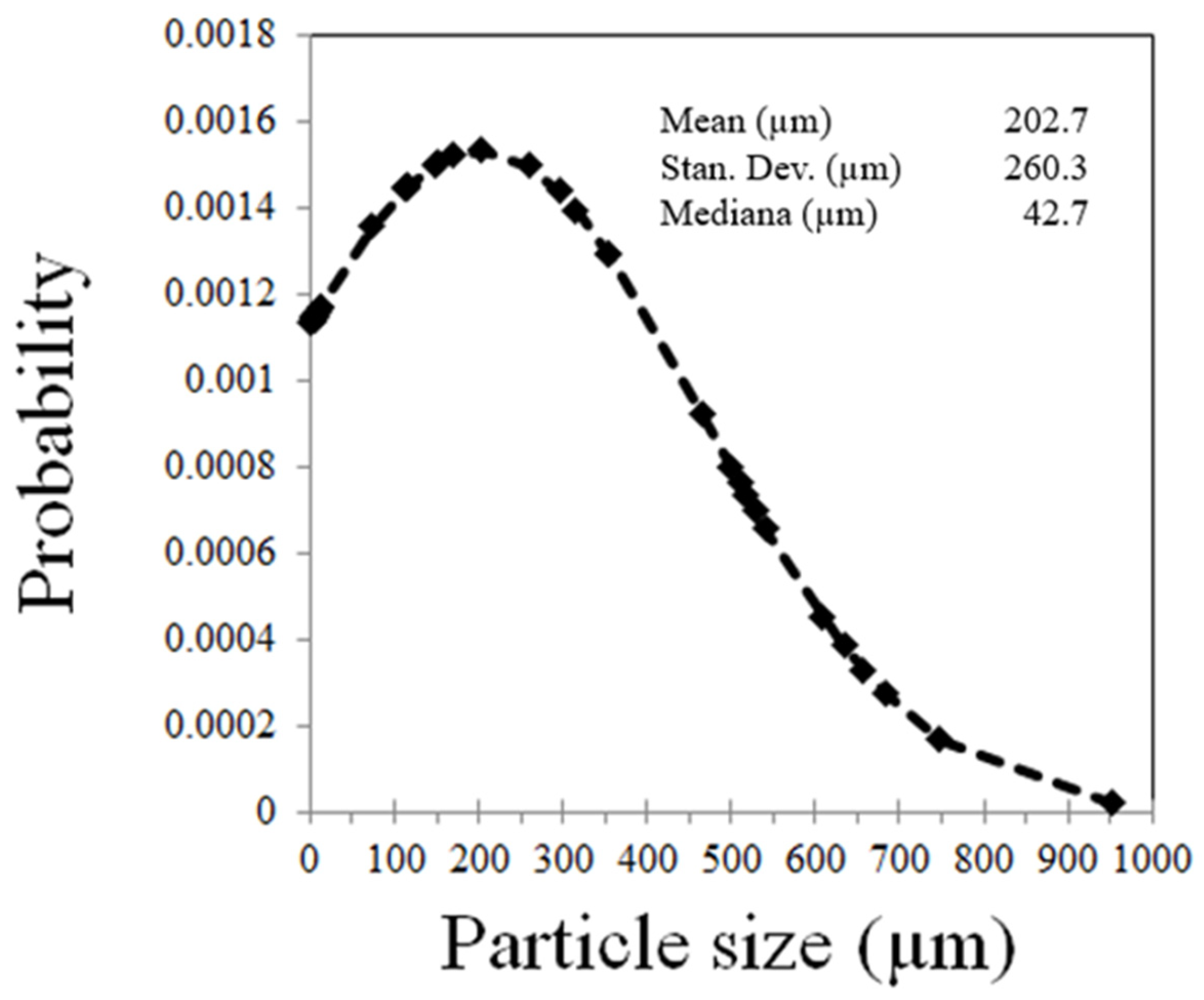
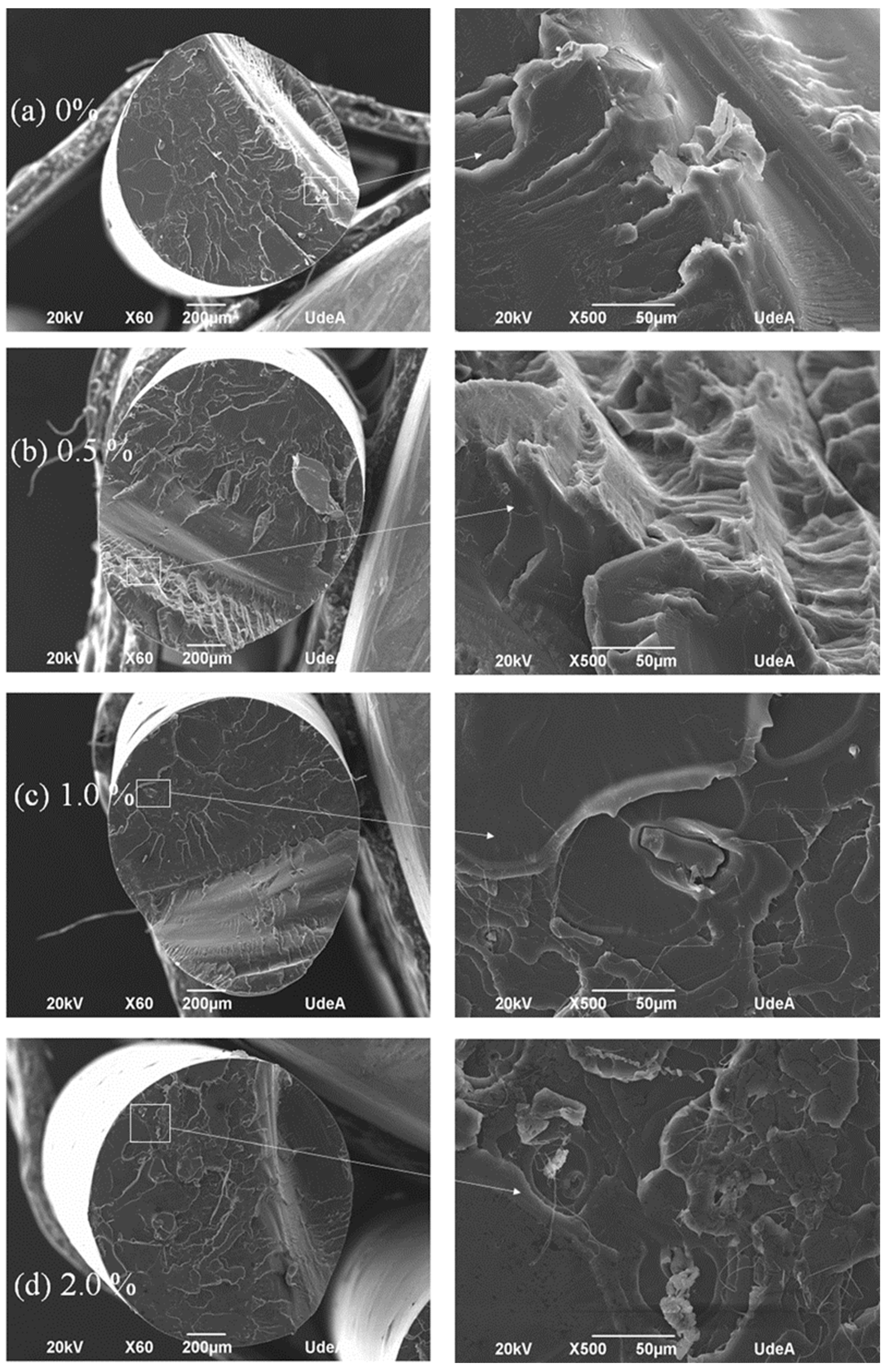
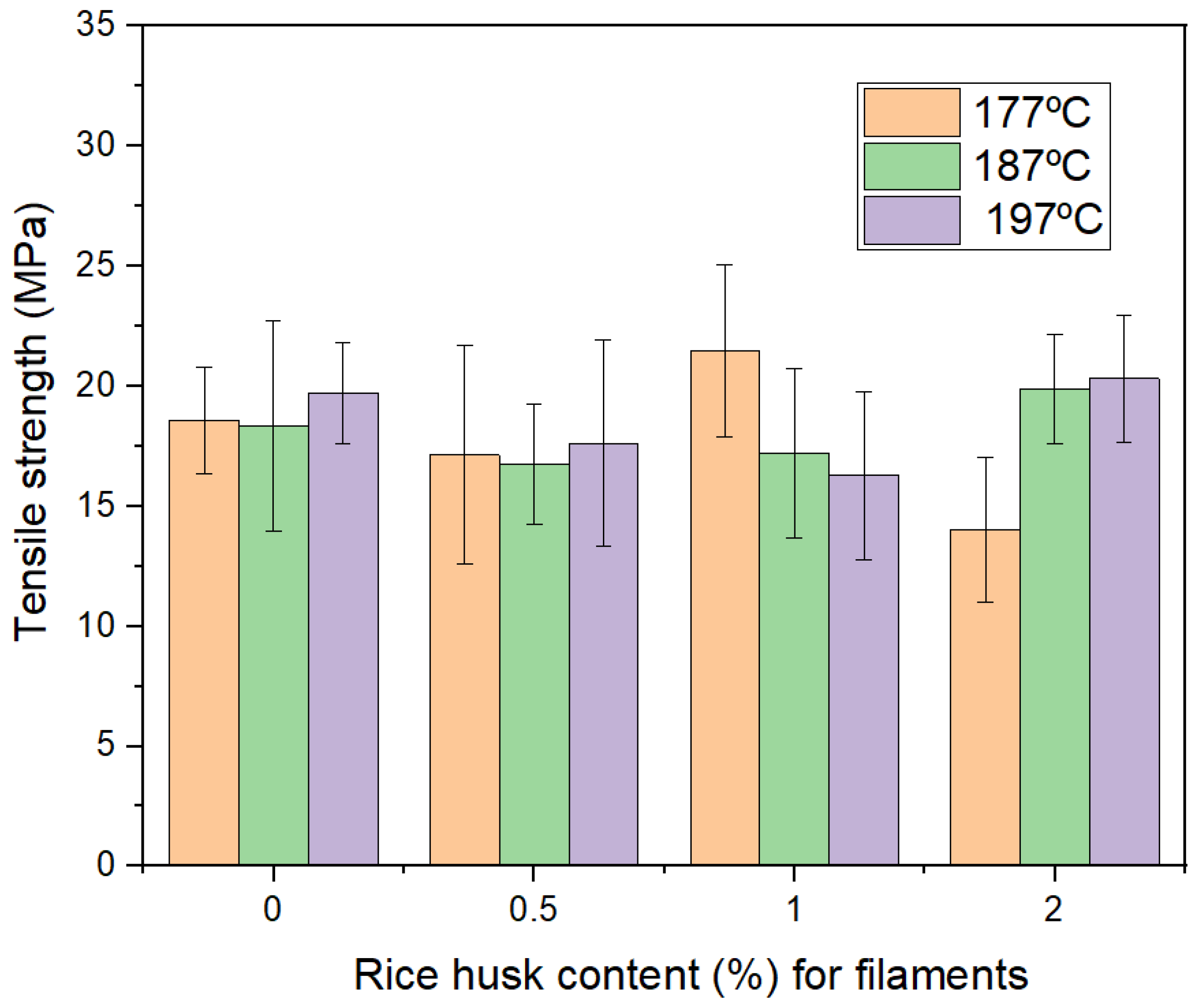
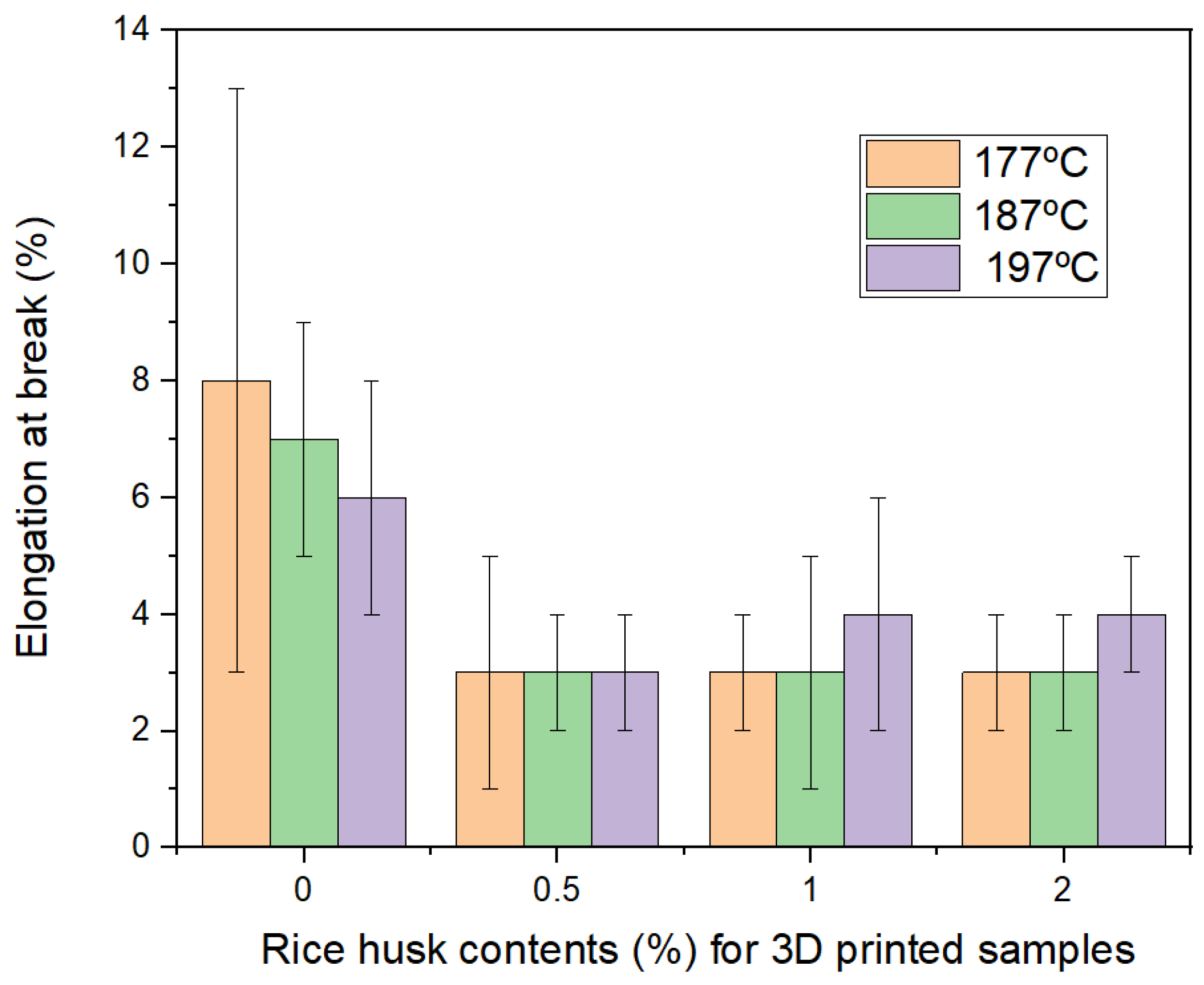

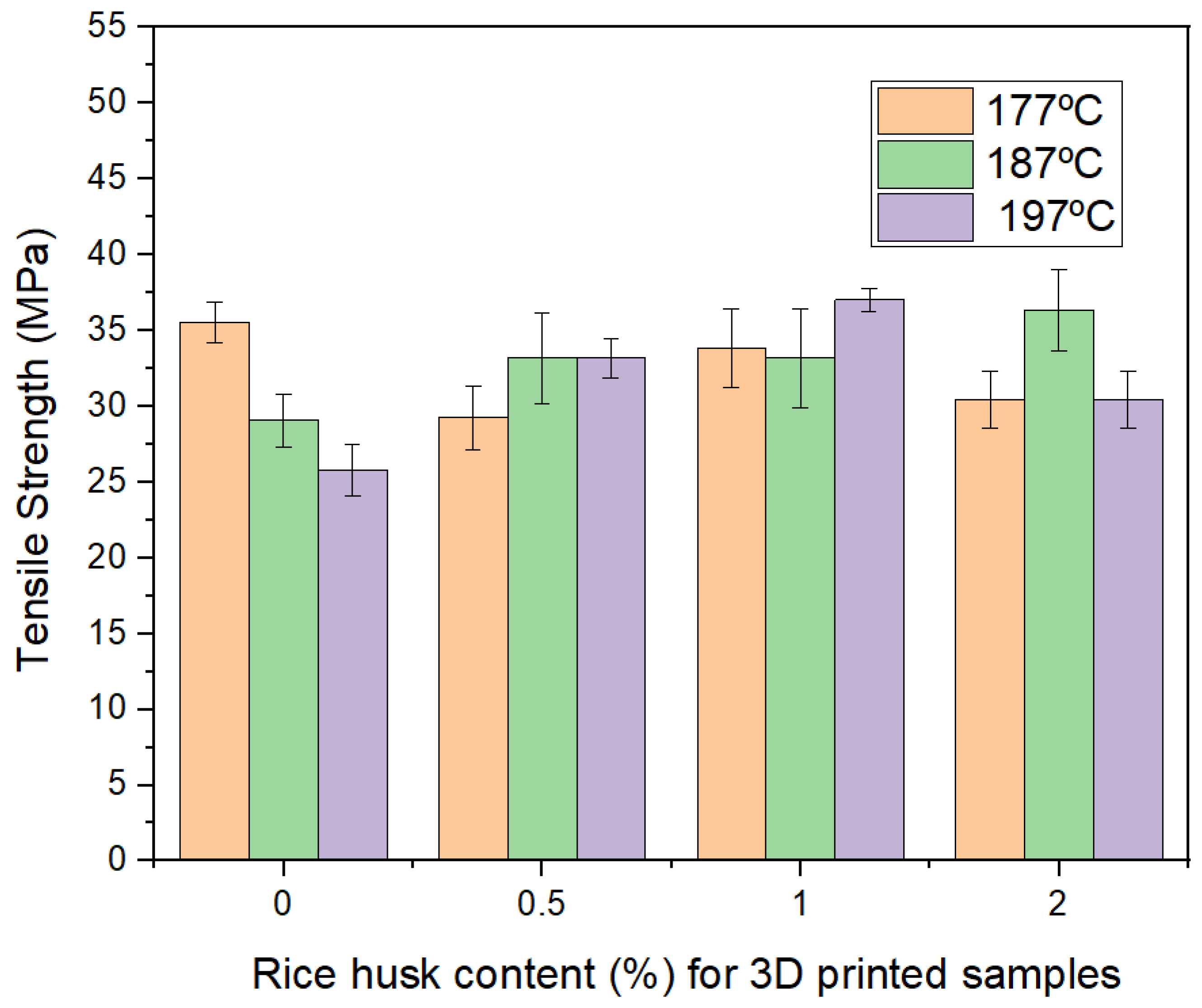
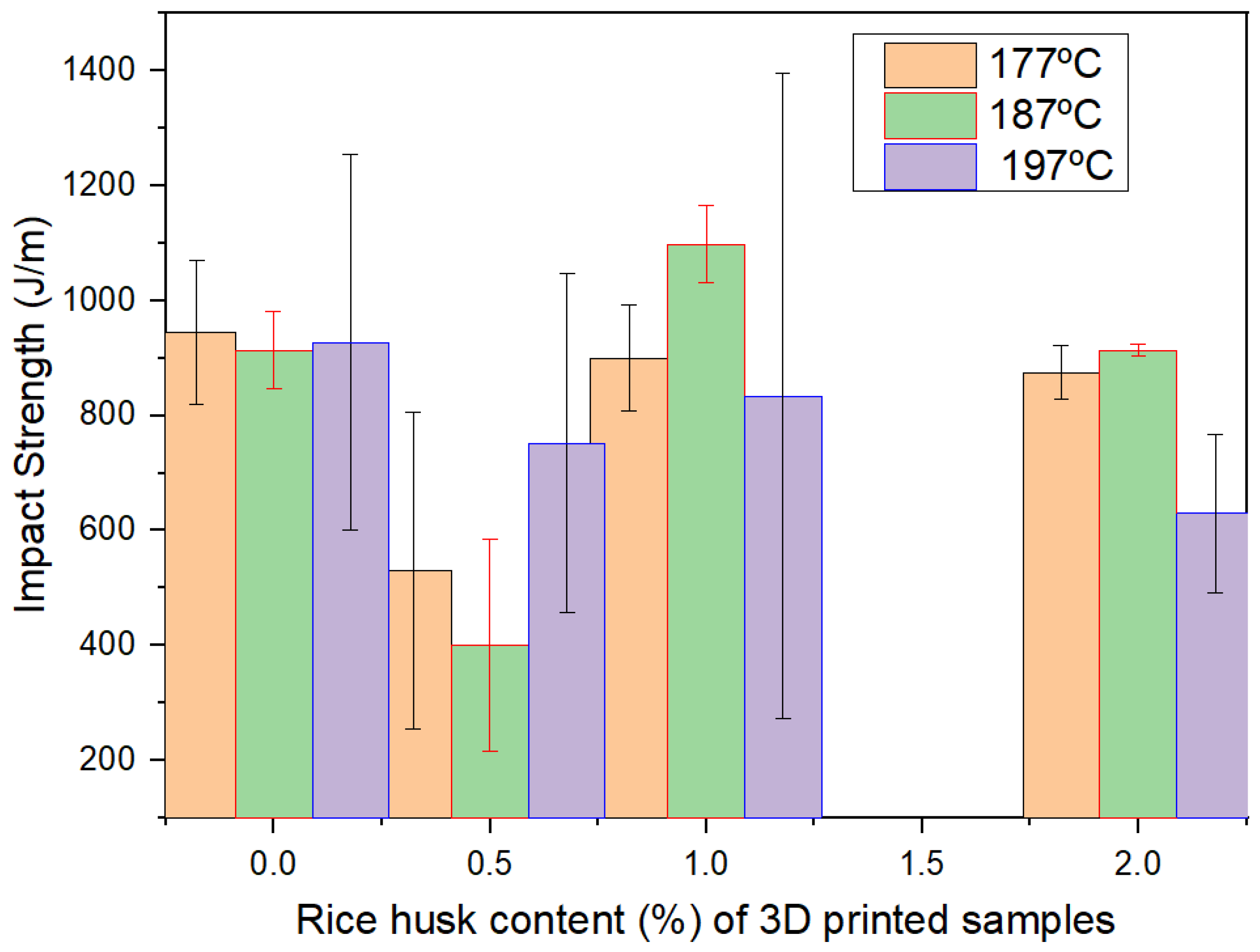
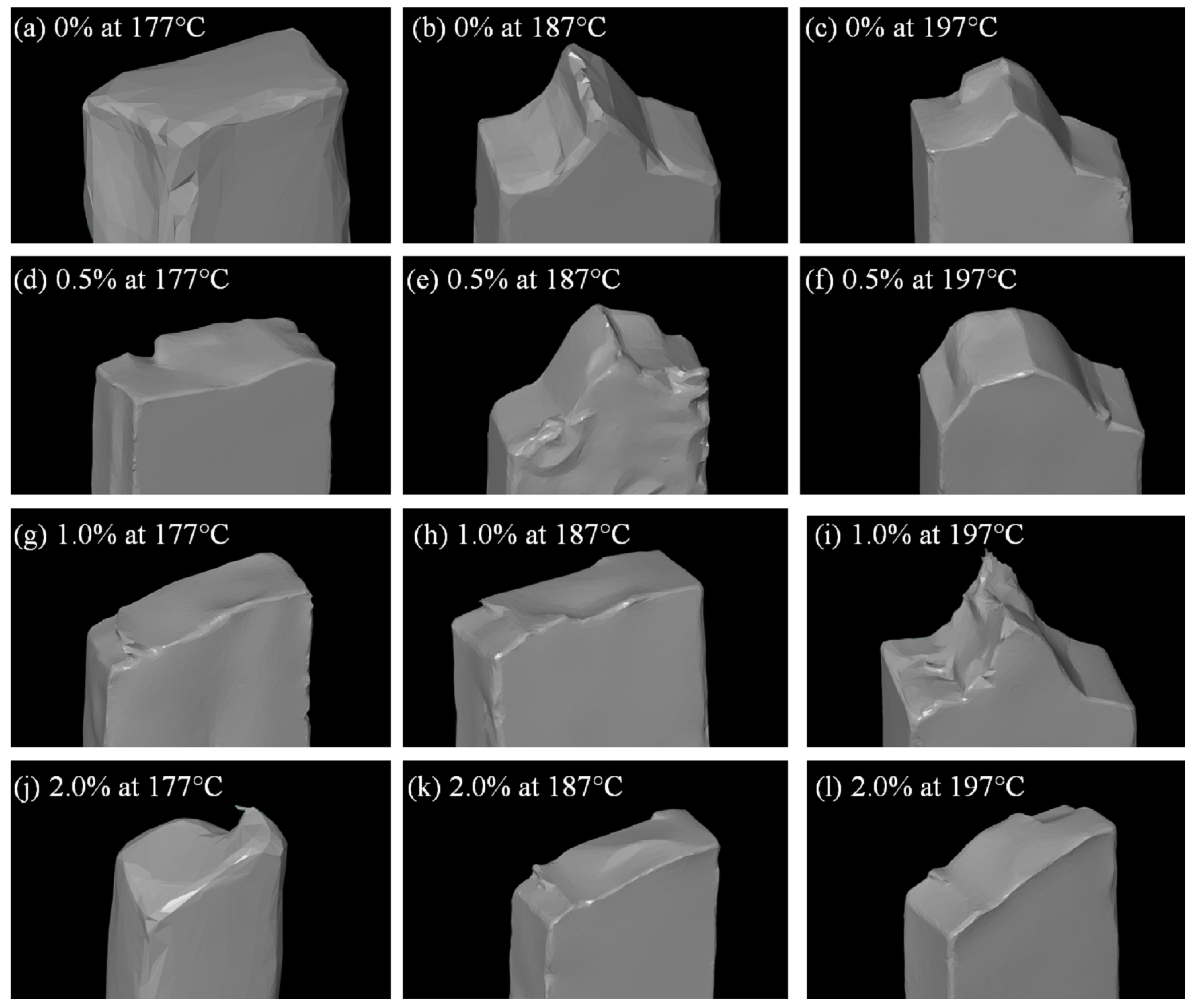
Disclaimer/Publisher’s Note: The statements, opinions and data contained in all publications are solely those of the individual author(s) and contributor(s) and not of MDPI and/or the editor(s). MDPI and/or the editor(s) disclaim responsibility for any injury to people or property resulting from any ideas, methods, instructions or products referred to in the content. |
© 2024 by the authors. Licensee MDPI, Basel, Switzerland. This article is an open access article distributed under the terms and conditions of the Creative Commons Attribution (CC BY) license (https://creativecommons.org/licenses/by/4.0/).
Share and Cite
Barreto, G.; Restrepo, S.; Vieira, C.M.; Monteiro, S.N.; Colorado, H.A. Rice Husk with PLA: 3D Filament Making and Additive Manufacturing of Samples for Potential Structural Applications. Polymers 2024, 16, 245. https://doi.org/10.3390/polym16020245
Barreto G, Restrepo S, Vieira CM, Monteiro SN, Colorado HA. Rice Husk with PLA: 3D Filament Making and Additive Manufacturing of Samples for Potential Structural Applications. Polymers. 2024; 16(2):245. https://doi.org/10.3390/polym16020245
Chicago/Turabian StyleBarreto, Gabriela, Santiago Restrepo, Carlos Mauricio Vieira, Sergio Neves Monteiro, and Henry A. Colorado. 2024. "Rice Husk with PLA: 3D Filament Making and Additive Manufacturing of Samples for Potential Structural Applications" Polymers 16, no. 2: 245. https://doi.org/10.3390/polym16020245





